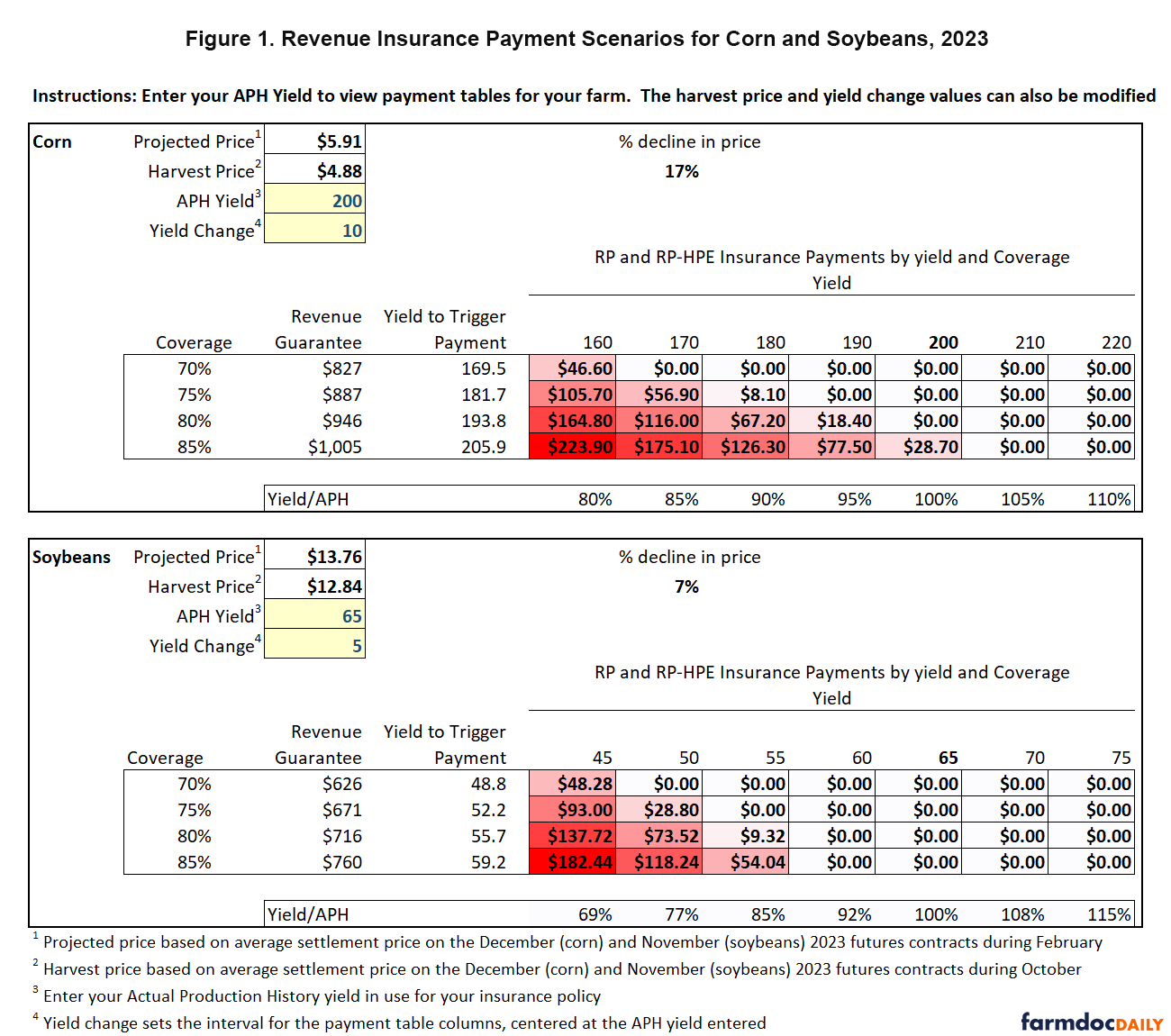2023 Harvest Prices and Revenue Insurance Payments for Corn and Soybeans
The October price discovery period for the Harvest Prices used in determining crop insurance indemnities for revenue products is now complete. The 2023 Harvest Price for corn is $4.88 per bushel, 17% below the Projected Price of $5.91 per bushel. The 2023 Harvest Price for soybeans is $12.84 per bushel, 7% below the $13.76 per bushel Projected Price.
Corn
Settlement prices for the December 2023 corn contract averaged $4.88 over the month of October. The $4.88 Harvest Price is $1.03, or 17%, below the Projected Price of $5.91. Because the Harvest Price is below the Projected Price the Revenue Protection (RP) and Revenue Protection with the Harvest Price Exclusion (RP-HPE) policies will both trigger the same level of indemnity payments.
Given the 17% price decline for corn, an RP or RP-HPE policy with an 85% coverage level would start to trigger payments with yields even slightly above a farm’s APH yield. Payments on 80% coverage level policies would require a 3% yield loss. Payments on 75% and 70% coverage level policies would require yields losses exceeding 9% and 15%, respectively.
As an example, consider a farm with a 200 bushel per acre APH yield. This would imply a revenue guarantee of $1,005 per acre ($5.91 x 200 = $1,005). An 85% revenue policy would start to trigger payments at a yield level of 205.9 bushels per acre. A farm yield of 200 bushels per acre would trigger an 85% RP or RP-HPE payment of $28.70 per acre (see upper panel of Figure 1). A farm yield of 160 bushels per acre would trigger an 85% RP or RP-HPE payment of nearly $223 per acre.
The upper panel of Figure 1 also shows payment scenarios for this example farm at alternative coverage levels for a revenue plan. A 75% RP or RP-HPE plan would start to trigger payments at a yield level of 181.7 bushels per acre. A 70% coverage revenue plan would require yields to be below 169.5 bushels per acre to trigger payments.
Soybeans
Settlement prices for the November 2023 soybean contract averaged $12.84 over the month of October. The $12.84 Harvest Price is $0.92, or 7%, below the Projected Price of $13.76. As with corn, because the Harvest Price is below the Projected Price, revenue policies (RP and RP-HPE) for soybeans will result in the same level of payments if they are triggered.
The 7% price decline for soybeans implies that yield losses, relative to a farm’s APH yield, will be required to trigger revenue policy indemnities. Payments on 85% coverage level policies will require a yield loss of approximately 9%. Yield losses required to trigger indemnities increase as the coverage level declines. Indemnities would be triggered on 70% coverage level policies with yield losses of at least 25%.
Consider a soybean farm with an APH yield of 65 bushels per acre. The $13.76 Projected Price implies a revenue guarantee for this farm of $760 per acre ($13.76 x 65 = $760). An 85% revenue policy would trigger payments with yields at or below 59.2 bushels per acre.
The lower panel of Figure 2 illustrates a range of payment scenarios at different revenue policy coverage levels for soybeans. At 55 bushels per acre, an 85% revenue policy would trigger a payment of $54 per acre. At 45 bushels per acre the 85% policy would trigger a $182 per acre payment. A 75% revenue policy would trigger payments with yields at or below 55.7 bushels per acre. A yield of 50 bushels per acre would trigger a $73.52 per acre payment on a 75% revenue policy.
Revenue Policy Payment Calculator
A final version of the 2023 Payment Calculator is now available. An initial version of this excel calculator was introduced in early October before the harvest prices were finalized (see farmdoc daily October 10, 2023). Users can enter their own APH yields to view and analyze payment outcomes for various coverage levels and at different yield levels.
Summary
The 2023 Harvest Prices are now set at $4.88 for corn and $12.84 for soybeans. This is a 17% decline from the $5.91 project price for corn, and a 7% decline from the $13.76 project price for soybeans. Because the Harvest Price is below the Projected Price for both crops, revenue policies will trigger the same payments regardless of whether they include the Harvest Price option (RP) or not (RP-HPE).
Revenue insurance indemnities will be triggered for 85% coverage policies on corn for yields even slightly above the farm’s APH yield. Yield losses, relative to the farm’s APH, will be needed to trigger payments at lower coverage levels. Revenue indemnities for soybean policies will require a yield loss even at the 85% coverage level.
Given the abnormally dry conditions experienced across most corn and soybean production regions in the U.S. during the 2023 growing seasons, yield losses sufficient to trigger insurance indemnities are likely to occur in many areas. In some areas insurance payments could be quite large.
References
Paulson, N., G. Schnitkey and B. Sherrick. “Potential Crop Insurance Payments for 2023.” farmdoc daily (13):185, Department of Agricultural and Consumer Economics, University of Illinois at Urbana-Champaign, October 10, 2023.
RMA. 2023. Price Discovery Tool, Risk Management Agency, United State Department of Agriculture. https://prodwebnlb.rma.usda.gov/apps/PriceDiscovery/GetPrices/YourPrice
Disclaimer: We request all readers, electronic media and others follow our citation guidelines when re-posting articles from farmdoc daily. Guidelines are available here. The farmdoc daily website falls under University of Illinois copyright and intellectual property rights. For a detailed statement, please see the University of Illinois Copyright Information and Policies here.








